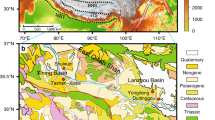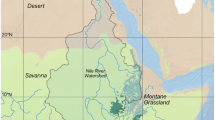Abstract
Between 34 and 15 million years (Myr) ago, when planetary temperatures were 3–4 °C warmer than at present and atmospheric CO2 concentrations were twice as high as today1, the Antarctic ice sheets may have been unstable2,3,4,5,6,7. Oxygen isotope records from deep-sea sediment cores suggest that during this time fluctuations in global temperatures and high-latitude continental ice volumes were influenced by orbital cycles8,9,10. But it has hitherto not been possible to calibrate the inferred changes in ice volume with direct evidence for oscillations of the Antarctic ice sheets11. Here we present sediment data from shallow marine cores in the western Ross Sea that exhibit well dated cyclic variations, and which link the extent of the East Antarctic ice sheet directly to orbital cycles during the Oligocene/Miocene transition (24.1–23.7 Myr ago). Three rapidly deposited glacimarine sequences are constrained to a period of less than 450 kyr by our age model, suggesting that orbital influences at the frequencies of obliquity (40 kyr) and eccentricity (125 kyr) controlled the oscillations of the ice margin at that time. An erosional hiatus covering 250 kyr provides direct evidence for a major episode of global cooling and ice-sheet expansion about 23.7 Myr ago, which had previously been inferred from oxygen isotope data (Mi1 event5).
This is a preview of subscription content, access via your institution
Access options
Subscribe to this journal
Receive 51 print issues and online access
$199.00 per year
only $3.90 per issue
Buy this article
- Purchase on Springer Link
- Instant access to full article PDF
Prices may be subject to local taxes which are calculated during checkout




Similar content being viewed by others
References
Freeman, K. H. & Hayes, J. M. Fractionation of carbon isotopes by phytoplankton and estimates of ancient CO2 levels. Glob. Biogeochem. Cycles 6, 185–198 (1992).
Barrett, P. J., Elston, D. P., Harwood, D. M., McKelvey, B. C. & Webb, P.-N. Mid-Cenozoic record of glaciation and sea-level change on the margin of the Victoria Land basin, Antarctica. Geology 15, 634–637 (1987).
Barrett, P. J. (ed.) Antarctic Cenozoic history from CIROS-1 drillhole, McMurdo Sound. DSIR Bull. 245, 1–254 (1989).
Hambrey, M. J., Ehrmann, W. U. & Larsen, B. Cenozoic glacial record of the Prydz Bay continental shelf, East Antarctica. Proc. ODP Sci. Res. 119, 77–132 (1991).
Miller, K. G., Wright, J. D. & Fairbanks, R. G. Unlocking the ice house: Oligocene oxygen isotopes, eustasy and margin erosion. J. Geophys. Res. 96, 6829–6848 (1991).
Wise, S. W., Breza, J. R., Harwood, D. M. & Wei, W. in Controversies in Modern Geology (eds Mueller, D., McKenzie, J. & Weissart, H.) 133–177 (Academic, San Diego, 1991).
Zachos, J. C., Breza, J. & Wise, S. W. Early Oligocene ice-sheet expansion on Antarctica: stable isotope and sedimentological evidence from Kerguelen Plateau, southern Indian Ocean. Geology 20, 569–573 (1992).
Zachos, J. C., Quinn, T. M. & Salamy, K. A. High-resolution deep-sea foraminiferal stable isotope records of the Eocene-Oligocene climate transition. Paleoceanography 11, 256–266 (1996).
Zachos, J. C., Flower, B. P. & Paul, H. Orbitally paced climate oscillations across the Oligocene/Miocene boundary. Nature 388, 567–570 (1997).
Paul, H. A., Zachos, J. C., Flower, B. P. & Tripati, A. Orbitally induced climate and geochemical variability across the Oligocene/Miocene boundary. Paleoceanography 15, 471–485 (2000).
Lear, C. H., Elderfield, H. & Wilson, P. A. Cenozoic deep-sea temperatures and global ice volumes from Mg/Ca in benthic foraminiferal calcite. Science 287, 269–272 (2000).
Hays, D. E. et al. General synthesis. Init. Rep. DSDP 28, 919–942 (1975).
Fielding, C. R., Naish, T. R., Woolfe, K. J. & Lavelle, M. A. Facies analysis and sequence stratigraphy of CRP-2/2A, Victoria Land Basin, Antarctica. Terra Antartica 7, 323–338 (2000).
Cape Roberts Science Team. Studies from the Cape Roberts Project, Ross Sea, Antarctica, Initial report on CRP-2/2A. Terra Antartica 6, 1–173 (1999).
Cape Roberts Science Team. Studies from the Cape Roberts Project, Ross Sea, Antarctica, Initial report on CRP-3. Terra Antartica 7, 1–209 (2000).
Henrys, S. A. et al. Correlation of seismic reflectors with CRP2/2A, Victoria Land Basin, Antarctica. Terra Antartica 7, 221–230 (2000).
Powell, R. D. A model for sedimentation by tidewater glaciers. Ann. Glaciol. 2, 129–134 (1981).
Naish, T. R. & Kamp, P. J. J. Sequence stratigraphy of 6th order (41 k.y.) Pliocene-Pleistocene cyclothems, Wanganui Basin, New Zealand: A case for the regressive systems tract. Geol. Soc. Am. Bull. 109, 978–999 (1997).
Passchier, S. Soft sediment deformation features in core from CRP-2/2A, Victoria Land Basin, Antarctica. Terra Antartica 7, 401–412 (2000).
Van der Meer, J. J. M. Microscopic observations on the first 300 metres of CRP-2/2A, Victoria Land Basin, Antarctica. Terra Antartica 7, 339–348 (2000).
Talarico, F., Sandroni, S., Fielding, C. F. & Atkins, C. Variability, petrography and provenance of basement clasts in core from CRP-2/2A. Victoria Land Basin, Antarctica. Terra Antartica 7, 529–544 (2000).
Scherer R., Bohaty, S. & Harwood, D. Oligocene and lower Miocene siliceous microfossil biostratigraphy for CRP-2/2A, Victoria Land Basin, Antarctica. Terra Antartica 7, 417–442 (2000).
Bücker, C., Wonik, T. & Jarrard, R. Analysis of downhole logging data from CRP-2/2A, Victoria Land Basin, Antarctica: a multivariate approach. Victoria Land Basin, Antarctica. Terra Antartica 7, 299–310 (2000).
McIntosh, W. C. 40Ar/39Ar geochronology of tephra and volcanic clasts in CRP-2/2A, Victoria Land Basin, Antarctica. Terra Antartica 7, 621–630 (2000).
Watkins, D. K. & Villa, G. Paleogene calcareous nannofossils from CRP-2/2A, Victoria Land Basin, Antarctica. Terra Antartica 7, 443–452 (2000).
Lavelle, M. Strontium isotope stratigraphy and age model for CRP-2/2A, Victoria Land Basin, Antarctica. Terra Antartica 7, 611–620 (2000).
Wilson, G. S., Florindo, F., Sagnotti, L., Roberts, A. & Verosub, K. Magnetostratigraphy of CRP-2/2A, Victoria Land Basin, Antarctica. Terra Antartica 7, 631–646 (2000).
Wilson, G. S. et al. Chronostratigraphy of the CRP-2/2A, Victoria Land Basin, Antarctica. Terra Antartica 7, 647–664 (2000).
Harwood, D. M. & Maruyama, T. Middle Eocene to Pleistocene diatom biostratigraphy of Southern Ocean sediments from the Kerguelen Plateau, Leg 120. Proc. ODP Sci. Res. 120, 683–733 (1992).
Hsü, K. J., Percival, S. F., Wright, R. & Peterson, N. P. Numerical ages of magnetostratigraphically calibrated biostratigraphic zones. Init. Rep. DSDP 73, 625–635 (1983).
Imbrie, J. et al. On the structure and origin of major glaciation cycles 2. The 100,000 year cycle. Paleoceanography 8, 699–735 (1993).
Houghton, J. et al. Climate Change 2001: The Scientific Basis (Third Assessment Report from IPCC Working Group 1), 1–944 (Cambridge Univ. Press, Cambridge, 2001).
Cande, S. C. & Kent, D. V. Revised calibration of the geomagnetic polarity time scale for the Late Cretaceous and Cenozoic. J. Geophys. Res. 100, 6093–6095 (1995).
Shackleton, N. J., Crowhurst, S. J., Weedon, G. P. & Laskar, J. Astronomical calibration of Oligocene-Miocene time. Phil. Trans. R. Soc. Lond. A 357, 1907–1929 (1999).
Laskar, J., Joutel, F. & Boudin, F. Orbital, precessional and insolation quantities for the Earth from -20Myr to +10Myr. Astron. Astrophys. 270, 522–533 (1993).
Shackleton, N. J., Hall, M. A., Raffi, I., Tauxe, L. & Zachos, J. Astronomical calibration for the Oligocene-Miocene boundary. Geology 28, 447–450 (2000).
Acknowledgements
This Letter is dedicated to the memory of Ken Woolfe, sedimentologist and ISC member of the Cape Roberts Project. The Cape Roberts Project was supported by the Antarctic programmes of Italy, New Zealand, the USA, Germany, Australia, the UK and The Netherlands, with field operations organised by Antarctica New Zealand. We acknowledge the efforts of the Cape Roberts Project International Steering Committee, the Operations/Logistics Management Group, as well as the drilling, logistic support and science teams who provided the material on which this Letter is based. We also acknowledge the support of our home institutions and funding agencies.
Author information
Authors and Affiliations
Corresponding author
Rights and permissions
About this article
Cite this article
Naish, T., Woolfe, K., Barrett, P. et al. Orbitally induced oscillations in the East Antarctic ice sheet at the Oligocene/Miocene boundary. Nature 413, 719–723 (2001). https://doi.org/10.1038/35099534
Received:
Accepted:
Issue Date:
DOI: https://doi.org/10.1038/35099534
This article is cited by
-
An ancient river landscape preserved beneath the East Antarctic Ice Sheet
Nature Communications (2023)
-
Large obliquity-paced Antarctic ice-volume fluctuations suggest melting by atmospheric and ocean warming during late Oligocene
Communications Earth & Environment (2023)
-
Response of the East Antarctic Ice Sheet to past and future climate change
Nature (2022)
-
Methane hydrate dissociation across the Oligocene–Miocene boundary
Nature Geoscience (2022)
-
Climatic and tectonic drivers of late Oligocene Antarctic ice volume
Nature Geoscience (2022)
Comments
By submitting a comment you agree to abide by our Terms and Community Guidelines. If you find something abusive or that does not comply with our terms or guidelines please flag it as inappropriate.



